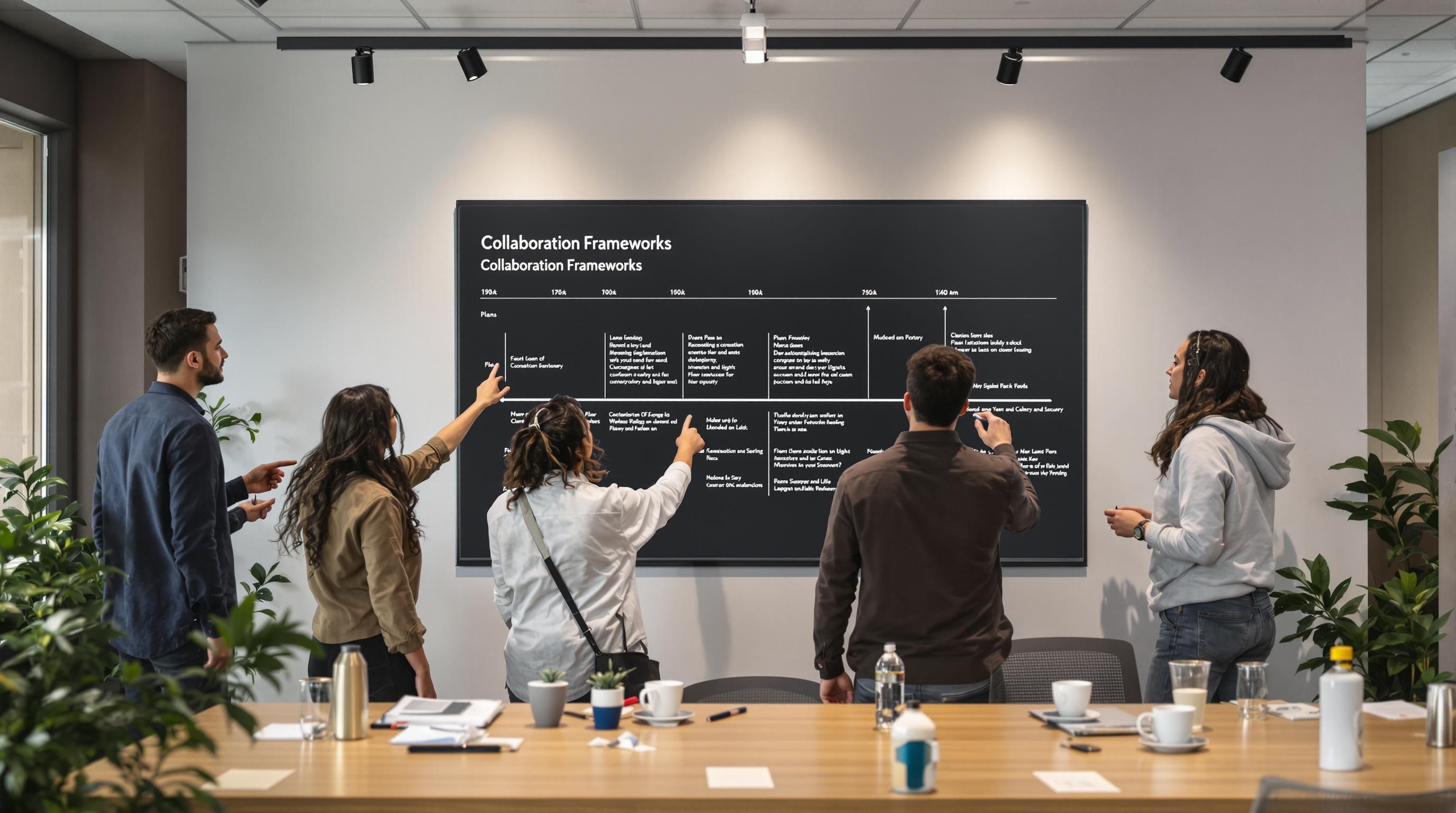Managing team schedules can feel like an endless juggling act especially as teams grow and work styles get more complex. But something surprising is happening as we move into 2025. Professionals now spend about 23 hours each week in meetings, with over 70 percent considered unproductive. Instead of just adding more tools or cramming in extra meetings, the teams setting new productivity records are rewriting their playbook entirely and it turns out the best results come from breaking old routines and focusing on smarter, not harder, coordination.
Table of Contents
- Mastering Team Calendars And Tools
- Smart Strategies For Meeting Scheduling
- Balancing Flexibility And Accountability
- Best Practices For Cross-Functional Teams
Quick Summary
| Takeaway | Explanation |
|---|---|
| Implement time block allocation. | Designate specific periods for collaborative and individual work to optimize productivity and avoid meeting overload. |
| Optimize meeting participants. | Invite only essential team members to meetings, ensuring that every participant is crucial to achieving the meeting’s objectives. |
| Establish outcome-oriented metrics. | Focus on deliverables rather than time worked, ensuring clarity in expectations and accountability among team members. |
| Utilize advanced calendar tools. | Leverage smart scheduling features to automate conflict resolution and improve team coordination in complex work environments. |
| Create strategic collaboration frameworks. | Develop clear communication protocols and shared objectives to enhance teamwork and overcome departmental silos effectively. |
Mastering Team Calendars and Tools
Team scheduling goes far beyond simply placing events on a calendar. Effective team calendar management requires strategic planning, clear communication, and smart technological integration. Discover advanced calendar optimization techniques that transform how teams coordinate and maximize productivity.
Understanding Modern Team Scheduling Challenges
In the complex landscape of team collaboration, scheduling represents a critical intersection of individual preferences and collective goals. Research exploring information workers’ scheduling practices reveals a significant gap between personal temporal preferences and actual scheduling realities. Teams frequently struggle with conflicting schedules, overlapping commitments, and inefficient meeting management.
The core challenges include time zone differences, varied work styles, asynchronous communication, and the increasing complexity of remote and hybrid work environments. Traditional calendar tools often fail to address these nuanced dynamics, leading to productivity bottlenecks and communication breakdowns.

Strategic Calendar Management Techniques
Successful team scheduling requires a multifaceted approach. According to productivity research examining meeting coordination, organizations can dramatically improve efficiency by implementing structured scheduling protocols.
Key strategies include:
-
Time Block Allocation: Designate specific periods for collaborative work, individual tasks, and buffer zones. This approach prevents meeting overload and respects individual productivity rhythms.
-
Preference-Based Scheduling: Incorporate team members’ peak productivity hours and personal scheduling constraints. This increases engagement and reduces scheduling friction.
-
Technology Integration: Utilize advanced calendar tools that offer smart scheduling features, automated conflict resolution, and seamless cross-platform synchronization.
Effective calendar management is not about rigid control but creating flexible frameworks that adapt to team dynamics. By understanding individual work patterns and leveraging intelligent scheduling technologies, teams can transform calendar management from a administrative task into a strategic productivity tool.
The future of team scheduling lies in AI-powered solutions that predict scheduling needs, recommend optimal meeting times, and automatically adjust to changing team configurations. As remote and distributed work continues to evolve, mastering these calendar tools becomes not just a convenience, but a competitive advantage.
To help you compare the major calendar management challenges teams face, here’s a table summarizing each challenge and its impact as discussed above:
| Scheduling Challenge | Description | Impact on Teams |
|---|---|---|
| Time Zone Differences | Team members distributed across different geographic regions | Difficult meeting coordination |
| Varied Work Styles | Differences in how team members prefer to structure their day | Reduced engagement and friction |
| Asynchronous Communication | Use of non-real-time channels for interaction | Potential delays and confusion |
| Remote/Hybrid Complexity | Mix of in-person, remote, and hybrid roles | Complicates synchronization |
| Traditional Tools Limit | Standard calendars lacking advanced, adaptive features | Productivity bottlenecks |
Smart Strategies for Meeting Scheduling
Meeting scheduling represents a critical yet often overlooked aspect of team productivity. Smart strategies can transform potentially unproductive gatherings into focused, efficient collaboration sessions. Learn advanced task management techniques that complement effective meeting planning.
Redefining Meeting Efficiency
Traditional meeting approaches often lead to wasted time and diminished team energy. According to organizational behavior research, poorly structured meetings can consume significant professional resources. A study from the Harvard Business Review indicates that professionals spend approximately 23 hours per week in meetings, with over 70% of those meetings considered unproductive.
The primary challenges include unclear objectives, excessive participant lists, lack of structured agendas, and inadequate time management. Successful teams recognize that meeting effectiveness is not about duration but about strategic engagement and clear outcomes.
Strategic Meeting Design Principles
Effective meeting scheduling demands a systematic approach. Key principles include:
-
Purpose-Driven Scheduling: Every meeting must have a clear, measurable objective. Determine whether the meeting requires synchronous communication or can be resolved through asynchronous channels.
-
Participant Optimization: Invite only essential team members. Use the “two-pizza rule” popularized by Amazon: if two pizzas cannot feed the entire meeting group, too many people are involved.
-
Time Management Techniques: Implement strict time boundaries. Consider techniques like the 25-minute focused meeting or the “walking meeting” to maintain energy and prevent unnecessary discussions.
Advanced teams are adopting data-driven scheduling approaches. AI-powered tools can now analyze team availability, predict optimal meeting times, and automatically generate agenda templates based on historical interaction patterns.
The most progressive organizations are moving beyond traditional meeting structures. They are implementing hybrid models that blend synchronous and asynchronous communication, respecting individual productivity rhythms while maintaining team connectivity.
Successful meeting scheduling is not about controlling time but about creating meaningful collaborative spaces. By implementing these strategic approaches, teams can transform meetings from productivity drains into powerful catalysts for innovation and collective achievement.
Below is a summary table highlighting the main principles for strategic meeting design, as discussed above:
| Principle | Description |
|---|---|
| Purpose-Driven Scheduling | Meetings must have a clear, measurable objective; consider async vs sync necessity |
| Participant Optimization | Only essential team members attend; follow “two-pizza rule” to keep numbers small |
| Time Management Techniques | Enforce strict time limits, e.g., 25-minute or “walking” meetings |
| Data-Driven Scheduling | Use AI/tools to find optimal times and auto-generate agendas |
| Hybrid Communication Models | Blend synchronous and asynchronous methods to fit team preferences |
Balancing Flexibility and Accountability
Modern team management requires a delicate equilibrium between providing workspace flexibility and maintaining robust accountability standards. Explore collaborative leadership strategies that help teams achieve this critical balance.
The New Paradigm of Work Flexibility
Research from the National Institutes of Health reveals that flexible work arrangements, when implemented strategically, can significantly enhance team productivity and individual job satisfaction. The traditional nine-to-five model is rapidly becoming obsolete, replaced by dynamic work environments that prioritize outcomes over rigid time tracking.
Flexibility does not mean an absence of structure. Instead, it represents a thoughtful approach to work that recognizes individual productivity patterns, personal responsibilities, and diverse working styles. Teams that successfully implement flexible models understand that performance is measured by results, not by hours spent at a desk.
Establishing Clear Accountability Frameworks
Accountability remains the cornerstone of effective team performance. Key strategies for maintaining accountability in flexible work environments include:
-
Outcome-Oriented Performance Metrics: Define clear, measurable objectives that focus on deliverables rather than time spent working.
-
Regular Check-In Protocols: Implement consistent communication touchpoints that allow teams to track progress, discuss challenges, and maintain alignment.
-
Transparent Goal Setting: Create shared visibility into individual and team objectives, ensuring everyone understands their responsibilities and contribution to collective goals.
Successful organizations recognize that accountability is not about micromanagement but about creating a culture of trust, mutual respect, and shared commitment. The most effective teams develop internal mechanisms that encourage self-regulation and proactive communication.
Technology plays a crucial role in supporting this balance. Advanced project management tools can provide real-time insights into team performance, track progress transparently, and facilitate seamless collaboration across different work environments.
The future of work is not about choosing between flexibility and accountability but about integrating these principles into a holistic approach to team management. By embracing adaptable work models that prioritize both individual autonomy and collective achievement, organizations can create resilient, high-performing teams that thrive in an increasingly complex professional landscape.
Best Practices for Cross-Functional Teams
Cross-functional teams represent the future of collaborative work, breaking down traditional organizational silos and fostering innovation through diverse perspectives. Discover collaborative decision-making strategies that transform how teams interact and achieve collective goals.
Understanding Cross-Functional Team Dynamics
Research examining team communication patterns reveals that daily stand-up meetings, while popular, can present significant challenges in cross-functional environments. The complexity increases when team members come from different departments, each with unique communication styles, priorities, and performance metrics.
Successful cross-functional teams require more than just assembling diverse talent. They demand a strategic approach that addresses potential friction points, establishes clear communication protocols, and creates a unified team identity that transcends departmental boundaries.
Strategic Collaboration Frameworks
According to the Canada School of Public Service, effective cross-functional teams rely on several critical practices:
-
Clear Milestone Definition: Establish transparent, measurable objectives that provide all team members with a shared understanding of progress and expectations.
-
Empowered Team Leadership: Select a team lead capable of navigating complex interdepartmental dynamics, managing conflicts, and maintaining team cohesion.
-
Shared Vision Alignment: Create a compelling narrative that connects individual contributions to the broader organizational goals, motivating team members across different functional areas.
Forbes Human Resources Council research emphasizes the importance of making cross-departmental projects visible and creating mechanisms for transparent communication.
Technology plays a crucial role in supporting cross-functional collaboration. Advanced project management platforms can provide real-time visibility, track individual and collective contributions, and create spaces for seamless communication across traditional organizational boundaries.
The most innovative organizations recognize that cross-functional teams are not just a trend but a fundamental reimagining of how work gets done. By breaking down barriers, embracing diverse perspectives, and creating flexible collaboration frameworks, teams can unlock unprecedented levels of creativity, efficiency, and organizational agility.
Here is a table summarizing the key practices for effective cross-functional collaboration described above:
| Practice | Description |
|---|---|
| Clear Milestone Definition | Set transparent, measurable objectives for shared understanding |
| Empowered Team Leadership | Appoint a lead who manages dynamics and keeps the team cohesive |
| Shared Vision Alignment | Link contributions to bigger organizational goals for motivation |
| Project Visibility | Ensure cross-departmental initiatives are visible and communicated |
| Transparent Communication | Use consistent protocols and tools for sharing updates and feedback |

Frequently Asked Questions
What are the best strategies for effective team scheduling?
Implement time block allocation, optimize meeting participants, utilize advanced calendar tools, and create strategic collaboration frameworks to improve scheduling efficiency.
How can I make meetings more productive?
Ensure meetings have clear, measurable objectives, limit participants to essential team members, manage time effectively, and adopt a hybrid model that combines synchronous and asynchronous communication.
What challenges do teams face with modern scheduling?
Common challenges include time zone differences, varied work styles, asynchronous communication issues, and limitations of traditional calendar tools, which can lead to inefficiencies and communication breakdowns.
How do flexible work arrangements impact team accountability?
Flexible work arrangements can enhance productivity and job satisfaction when combined with clear accountability frameworks, such as outcome-oriented performance metrics and regular check-ins to maintain alignment.
Ready to Reclaim Your Team’s Time in 2025?
Are you overwhelmed by complicated schedules, unproductive meetings, or constant calendar conflicts? Modern teams often lose precious hours to poor coordination and ineffective tools, as highlighted in this article. With more than 70 percent of meetings labeled unproductive and teams struggling with scattered tasks and manual planning, the pain of wasted time is real. If you want truly smart calendar management, seamless collaboration, and time-saving automation, it is time to work differently.

See how Gammatica’s AI-driven platform can automate task planning, align calendars, and transform meetings into actionable results. Discover how features such as advanced calendar coordination and checklist automation together with effortless integrations, can give your team up to 16 more productive hours every week. Visit https://gammatica.com today and join business leaders who are turning scheduling chaos into clarity. Start now to get ahead of the productivity curve.
Recommended
- How to Manage Tasks Effectively in 2025: Proven Strategies for Leaders | Gammatica
- Project Progress Tracking: Strategies for Success in 2025 | Gammatica
- Automation for Small Businesses: Essential Strategies for 2025 | Gammatica
- Collaborative Decision Making for Leaders: Strategies for 2025 | Gammatica



